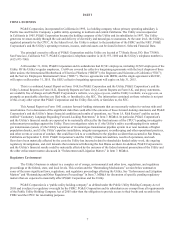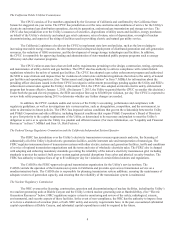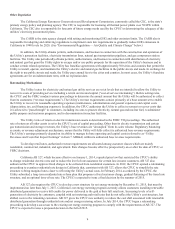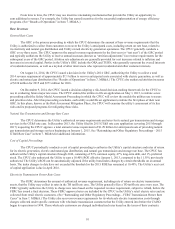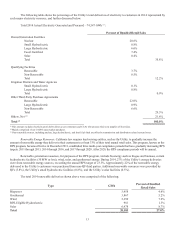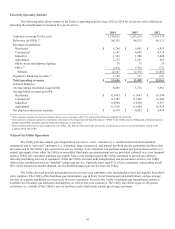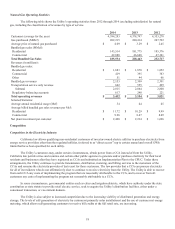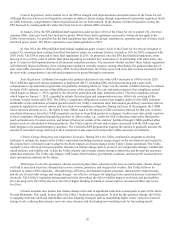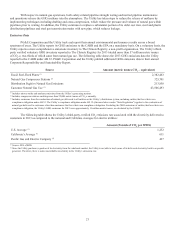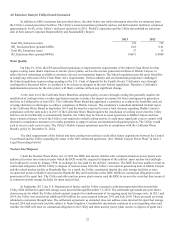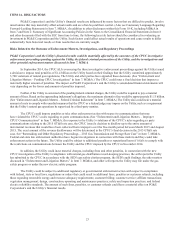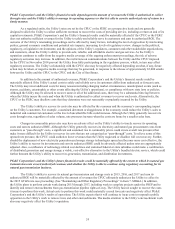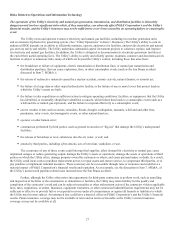PG&E 2014 Annual Report Download - page 25
Download and view the complete annual report
Please find page 25 of the 2014 PG&E annual report below. You can navigate through the pages in the report by either clicking on the pages listed below, or by using the keyword search tool below to find specific information within the annual report.17
Natural Gas Supplies
The Utility can receive natural gas from all the major natural gas basins in western North America, including basins in
western Canada, the Rocky Mountains, and the southwestern United States. The Utility also is supplied by natural gas fields in
California. The Utility purchases natural gas to serve its core customers directly from producers and marketers in both Canada
and the United States. The contract lengths and natural gas sources of the Utility’s portfolio of natural gas purchase contracts have
fluctuated generally based on market conditions. During 2014, the Utility purchased approximately 269,590 MMcf of natural gas
(net of the sale of excess supply of gas). Substantially all this natural gas was purchased under contracts with a term of one year or
less. The Utility’s largest individual supplier represented approximately 17% of the total natural gas volume the Utility purchased
during 2014.
Natural Gas System Assets
The Utility owns and operates an integrated natural gas transmission, storage, and distribution system that includes most
of northern and central California. At December 31, 2014, the Utility’s natural gas system consisted of approximately 42,700
miles of distribution pipelines, over 6,400 miles of backbone and local transmission pipelines, and various storage facilities. The
Utility owns and operates eight natural gas compressor stations on its backbone transmission system and one small station on its
local transmission system that are used to move gas through the Utility’s pipelines. The Utility’s backbone transmission system,
composed primarily of Lines 300, 400, and 401, is used to transport gas from the Utility’s interconnection with interstate pipelines,
other local distribution companies, and California gas fields to the Utility’s local transmission and distribution systems.
The Utility has firm transportation agreements for delivery of natural gas from western Canada to the United States-
Canada border with TransCanada NOVA Gas Transmission, Ltd. and TransCanada Foothills Pipe Lines Ltd., B.C. System. These
companies’ pipeline systems connect at the border to the pipeline system owned by Gas Transmission Northwest, LLC, which
provides natural gas transportation services to a point of interconnection with the Utility’s natural gas transportation system on the
Oregon-California border near Malin, Oregon. The Utility also has firm transportation agreements with Ruby Pipeline, LLC to
transport this gas from the U.S Rocky Mountains to the interconnection point with the Utility’s natural gas transportation system
in the area of Malin, Oregon, at the California border, and firm transportation agreements with Transwestern Pipeline Company,
LLC and El Paso Natural Gas Company to transport this natural gas from supply points in the U.S. Southwest to interconnection
points with the Utility’s natural gas transportation system in the area of California near Topock, Arizona. The Utility also has a
transportation agreement with Kern River Gas Transmission Company to transport gas from the U.S. Rocky Mountains to the
interconnection point with the Utility’s natural gas system in the area of Daggett, California. For more information regarding the
Utility’s natural gas transportation agreements, see Note 14 of the Notes to the Consolidated Financial Statements in Item 8.
The Utility owns and operates three underground natural gas storage fields and has a 25% interest in a fourth storage field,
all of which are connected to the Utility’s transmission system. The Utility owns and operates compressors and other facilities at
these storage fields that are used to inject gas into the fields for storage and later withdrawal. In addition, four independent storage
operators are interconnected to the Utility’s northern California transmission system.
The Utility also owns and operates a 42,000-square-foot control center in San Ramon, California to monitor and control
all aspects of its natural gas system across its service area.
During 2014, the Utility completed its system-wide replacement of 847 miles of cast iron natural gas distribution
pipeline with plastic pipe. Additionally, the Utility conducted an annual system-wide review of its transmission pipeline class
location designations. As part of its distribution integrity management program, during 2014 the Utility completed inspections of
approximately 35,000 sewer laterals.
Since work began on the PSEP and other gas transmission work in 2011, the Utility has validated the maximum allowable
operating pressure for all of its transmission pipelines through records verification; accomplished four-year goal of strength testing
or records validation of 783 miles of transmission pipeline; replaced 127 miles of transmission pipeline; automated 208 valves; and
collected and digitized more than 3.8 million pipeline records.


